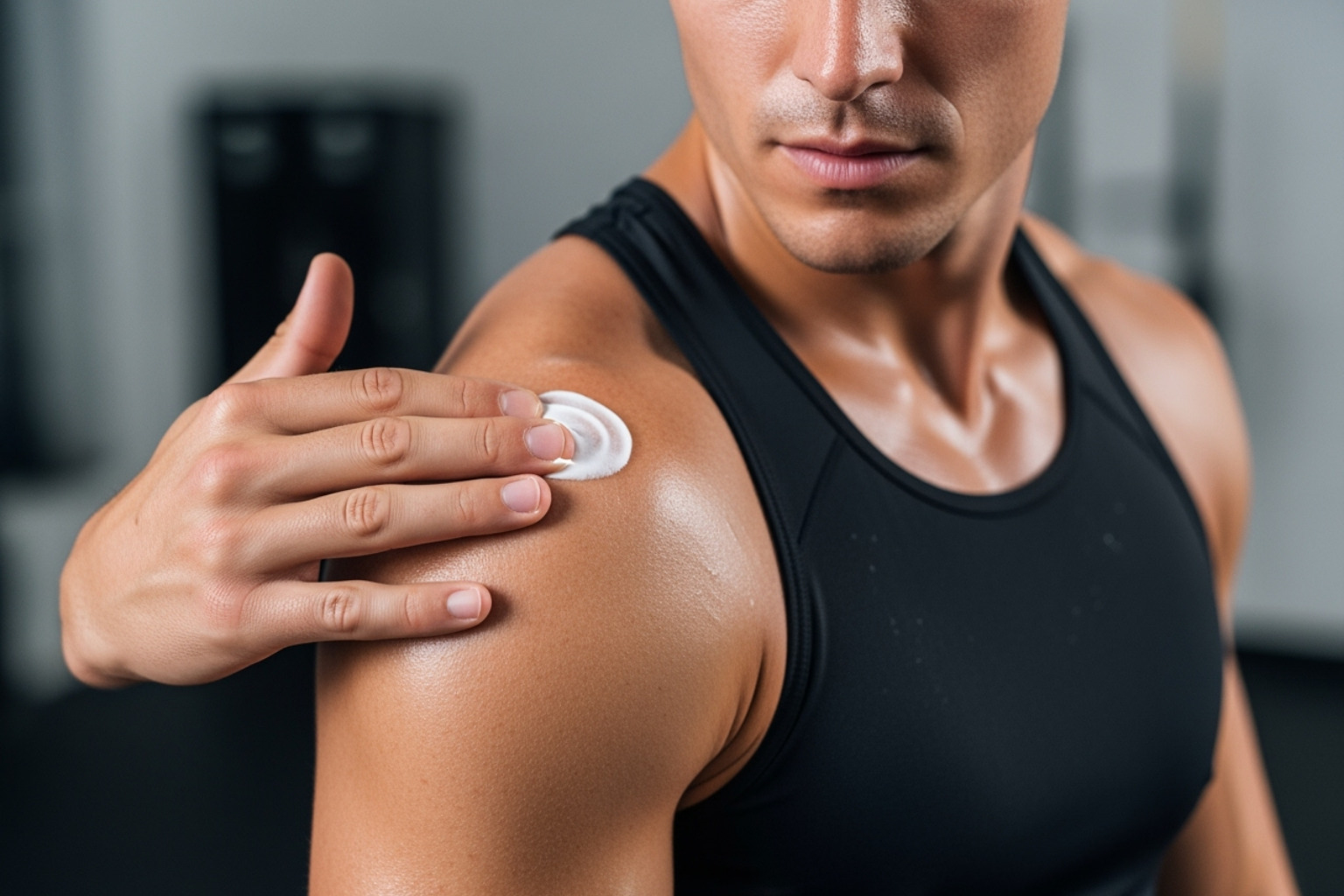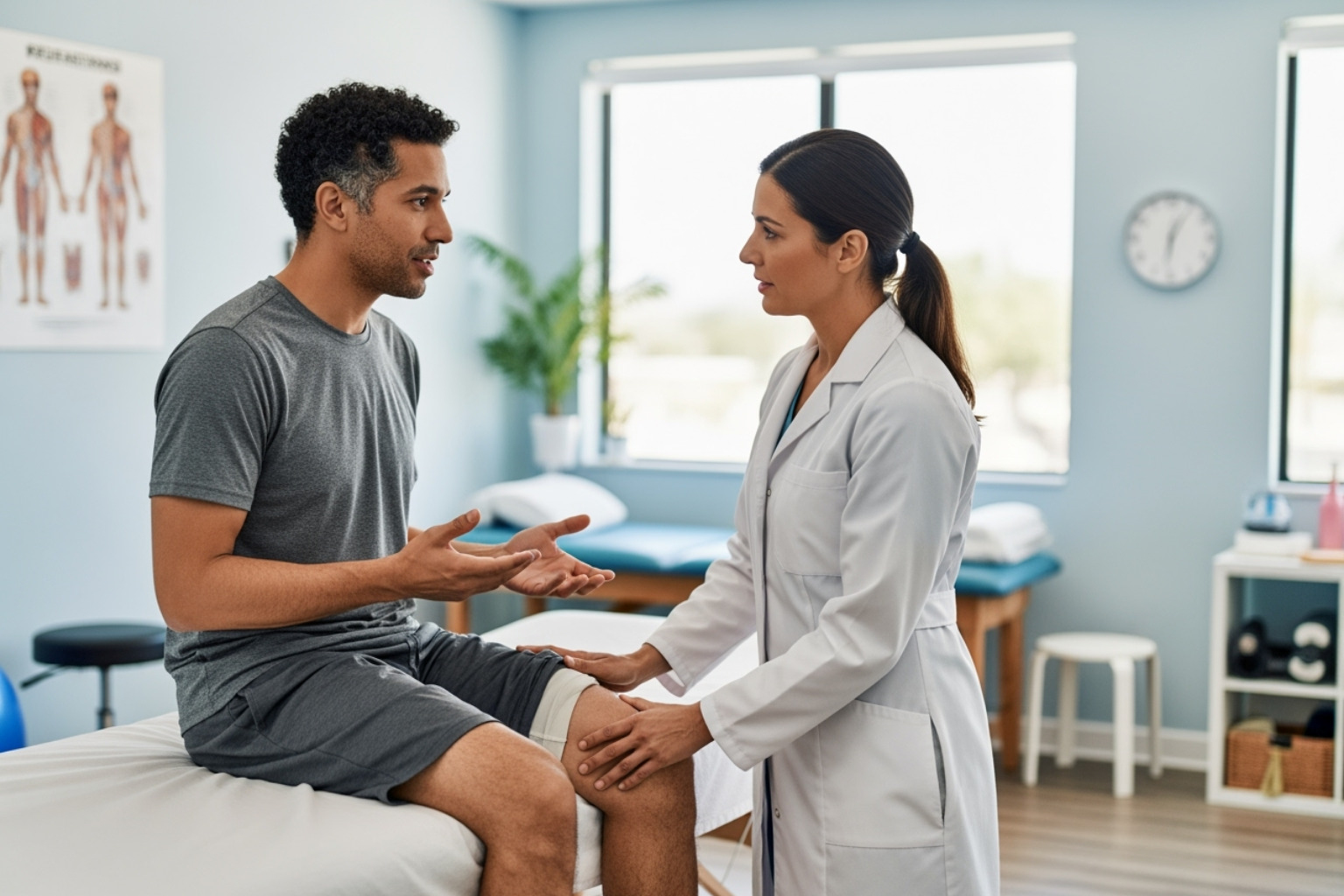Why Post Workout Muscle Relief Matters for Every Athlete and Active Adult
Post workout muscle relief is essential for anyone who trains regularly or pushes their body through physical activity. Whether you're an athlete chasing performance goals or someone dealing with persistent soreness after exercise, understanding how to manage post-workout discomfort can dramatically improve your recovery time and quality of life.
Quick Answer: The Most Effective Post Workout Muscle Relief Strategies
- Active Recovery - Light movement like walking or gentle yoga to increase blood flow
- Proper Nutrition - Protein and anti-inflammatory foods to fuel muscle repair
- Quality Sleep - 7-9 hours for optimal muscle rebuilding and growth hormone release
- Targeted Relief - Topical creams with menthol, aloe vera, and urea for fast-acting comfort
- Temperature Therapy - Ice for inflammation, heat for relaxation and blood flow
- Self-Massage - Foam rolling to release tension and improve circulation
That familiar ache that hits 24 to 48 hours after a tough workout? That's Delayed Onset Muscle Soreness (DOMS)—and it affects many fitness enthusiasts at some point. It's your body's natural response to microscopic tears in muscle fibers, triggered by challenging or unfamiliar movements.
The good news? DOMS is a sign your muscles are adapting and getting stronger. The even better news? You don't have to suffer through it without help.
Most muscle soreness peaks around 48 to 72 hours after exercise and typically resolves within 2 to 5 days.pdf?sfvrsn=8f430e18_2). During this window, your body is hard at work repairing those tiny muscle tears and building back stronger tissue. But there's a crucial difference between productive soreness and actual injury—and knowing that difference can save you weeks of setback.
This guide walks you through natural recovery strategies that work with your body's repair process, not against it. From nutrition and sleep to foam rolling and topical relief, you'll learn how to speed up recovery, reduce discomfort, and get back to training sooner.
Topical relief, in particular, offers a game-changing advantage: it delivers targeted comfort directly where you need it most, without the wait time of oral solutions. Natural ingredients like menthol provide cooling relief, while aloe vera soothes and urea helps the formula penetrate deep into tired muscles.
I'm Tony Enrico, and I've spent years helping athletes and active adults reclaim their strength and comfort through natural post workout muscle relief solutions. At Neuropasil, we've made it our mission to provide fast-acting, science-backed relief that helps you keep moving toward your goals—without harsh chemicals or empty promises.

Understanding Post-Workout Pain: What is DOMS?
That deep, uncomfortable ache that creeps in a day or two after a tough workout is Delayed Onset Muscle Soreness—or DOMS. It affects nearly everyone who trains hard, from marathon runners to people just getting back into the gym.
DOMS isn't an injury. It's your body's normal response to exercise that's new or more intense than usual.
So what's happening? When you exercise, especially during movements where muscles lengthen under tension (called eccentric contractions, like running downhill or lowering a weight), you create microscopic tears in your muscle fibers.
Once those micro-tears form, your body initiates an inflammatory repair process. The soreness you feel isn't the tears themselves, but the inflammation as your body patches things up and builds back stronger.
According to a scientific review of DOMS treatment strategies, this process is well-documented. The inflammation is a sign your muscles are adapting to handle that stress better next time.
DOMS has recognizable symptoms, including muscle tenderness, stiffness that limits your range of motion, and a dull, generalized ache. You might also experience temporary strength loss, feeling less powerful than usual.
The timeline for DOMS is predictable. It usually starts 8 to 12 hours after your workout, peaks around the 48 to 72-hour mark.pdf?sfvrsn=8f430e18_2), and gradually fades within 2 to 5 days.
The good news is that while DOMS is uncomfortable, it's a crucial part of how your muscles adapt and grow. Each time your body goes through this repair process, it builds more resilient tissue.
The key is knowing how to support your body during this recovery phase—and that's where smart post workout muscle relief strategies make all the difference.
Foundational Recovery: Movement, Nutrition & Rest
Effective post workout muscle relief is built on three interconnected pillars: movement, nutrition, and rest. Each is essential, and each amplifies the benefits of the others to help your body heal, adapt, and come back stronger.

Active Recovery & Gentle Stretching
When your muscles are sore, complete rest might feel logical, but your body actually recovers faster with gentle movement. This is where active recovery comes in. Low-impact activities like a leisurely walk, a relaxing swim, or a gentle yoga session get your blood flowing without adding more stress. This increased circulation delivers fresh oxygen and nutrients to your muscles while flushing away metabolic waste products that contribute to soreness.
Gentle stretching also helps. Dynamic stretching (like leg swings or arm circles) or light static holds can maintain your range of motion and ease post-workout stiffness. The goal isn't to push into deep, intense stretches, but to ease tension gradually. The Mayo Clinic provides excellent guidance on the importance of flexibility for recovery and injury prevention. For practical tips, see a guide to reducing muscle soreness after a workout.
Fueling Your Muscles: The Role of Nutrition & Hydration
What you eat and drink after training can dramatically impact your recovery speed.
Protein is crucial for repairing the microscopic muscle tears from exercise. Aim for 20 to 40 grams of protein from sources like chicken, a protein shake, or Greek yogurt within a couple of hours after your workout. This kickstarts muscle protein synthesis—the process of rebuilding stronger tissue.
Carbohydrates play a vital supporting role. They replenish the glycogen (your body's carb reserves) burned during exercise. Carbs also trigger insulin release, which helps shuttle nutrients into muscle cells for faster repair. Pairing carbs with protein after training is more effective than either one alone.
Foods that actively fight inflammation also help. For example, leafy greens and berries are rich in antioxidants that neutralize free radicals produced during intense exercise. Including a variety of anti-inflammatory foods in your diet can support the repair process.
Hydration is essential. Dehydration can make DOMS symptoms feel worse. Water transports nutrients, carries away waste, and regulates body temperature. Drink about 8 ounces of water for every 15 to 30 minutes of exercise, and consider replenishing electrolytes after intense or long sessions. For more nutritional strategies, explore what helps sore muscles after a workout.
The Power of Sleep for Muscle Repair
Many athletes focus on training and macros but neglect one of the most powerful recovery tools: quality sleep. Restorative sleep gives your body the time it needs to rebuild.
During deep sleep, your body releases Human Growth Hormone (hGH), which is vital for muscle growth and tissue repair. Sleep also plays a critical role in protein synthesis, the process that repairs muscle tears. Research has clearly demonstrated how sleep aids protein synthesis and muscle repair, making it as important as your workout.
Aim for 7 to 9 hours of quality sleep each night. Skimping on sleep undermines recovery by increasing cortisol, a stress hormone that can break down muscle tissue. Think of sleep as your muscles' dedicated repair shop.
Targeted Relief: Massage, Temperature & Topical Creams
While foundational recovery strategies build your long-term resilience, sometimes you need relief right now. When that deep muscle ache hits and you've got another workout (or just life) ahead of you, targeted relief methods can provide the comfort you need to keep moving forward.

Hands-On Help: Self-Massage and Foam Rolling
Think of self-massage and foam rolling as having a personal massage therapist in your living room, available whenever you need them. These techniques—collectively called self-myofascial release—work by applying pressure to release tension in your fascia, the connective tissue that wraps around your muscles like a protective web.
Foam rolling has become a gym staple for good reason. Using a cylindrical foam roller, you can target specific muscle groups by slowly rolling over tight or tender areas. This pressure helps break up adhesions (those stubborn muscle knots), boosts blood flow to starved tissues, and gradually improves your flexibility. It's essentially a deep tissue massage you control yourself, allowing you to adjust the pressure and focus exactly where you need it most.
For those smaller, harder-to-reach spots, self-massage with your hands, a tennis ball, or even a massage gun can be incredibly effective. These tools help increase local circulation, reduce inflammation, and provide immediate relief to those nagging sore spots that foam rolling might miss.
The science backs this up too. Research on massage for DOMS found that massage reduced swelling and alleviated DOMS pain by 30%—that's a significant improvement when you're trying to stay consistent with your training. Regular use of these techniques can genuinely transform how quickly you bounce back from tough workouts. For more hands-on strategies to accelerate your recovery, explore our guide on how to relieve soreness and recover fast.
Temperature Therapy: The Hot vs. Cold Debate
The ice-versus-heat debate is as old as sports medicine itself. The good news? You don't have to choose sides permanently. Both have their moment to shine in your post workout muscle relief routine, depending on what your body needs at different stages of recovery.
| Feature | Cold Therapy (Ice) | Heat Therapy (Warm Compresses, Baths) |
|---|---|---|
| Benefits | Reduces inflammation, numbs pain, decreases swelling | Increases blood flow, relaxes muscles, soothes discomfort |
| Timing | Immediately after exercise or within the first 24 hours (for acute inflammation) | 24-48 hours post-exercise, or before bed (for muscle relaxation) |
| Best Use | Acute soreness, swelling, throbbing pain | Muscle stiffness, chronic aches, relaxation |
Cold therapy—whether it's an ice pack, cold shower, or ice bath—works by constricting blood vessels, which reduces inflammation and numbs pain receptors. This makes it particularly valuable right after a grueling workout or when you're dealing with acute swelling. Think of it as hitting the "pause button" on inflammation before it gets out of hand.
Heat therapy, on the other hand, does the opposite: it dilates blood vessels, increasing blood flow and bringing fresh oxygen and nutrients to tired muscles. A warm bath or heating pad can work wonders for relaxing tight, stiff muscles.
Topical Solutions for Fast-Acting Post Workout Muscle Relief
Sometimes you need relief that doesn't require waiting around or treating your whole body when only one area hurts. That's where topical solutions become absolute game-changers. Unlike oral pain relievers that need to travel through your digestive system, topical creams deliver targeted, localized relief exactly where you need it, exactly when you need it.
The best topical solutions for post workout muscle relief harness specific natural ingredients that work together to address both muscle and nerve discomfort. Menthol creates that refreshing cooling sensation that can effectively numb pain receptors—it's like giving your overworked muscles a cool, soothing breeze. Aloe Vera brings its well-known anti-inflammatory and soothing properties to calm irritated tissues and support natural healing. And Urea does double duty: it moisturizes deeply while also helping other active ingredients penetrate further into the tissue where relief is needed most.
At Neuropasil, we've built our entire mission around providing natural, fast-acting relief that helps active people stay active. Our unique formula combines Aloe, Urea, and Menthol to penetrate deeply, soothing tired muscles and irritated nerves without harsh chemicals. While many people reach for our cream after tough workouts, we've been humbled to hear from customers who also rely on it for neuropathy, sciatica, fibromyalgia, plantar fasciitis, strains, sprains, joint discomfort, back and neck pain, cramps, and aching feet. Athletes especially appreciate having a natural option that delivers real relief without compromising their training schedule.
If you're looking to understand more about how these creams work and what to look for, check out the ultimate guide to muscle relief cream. Because at the end of the day, effective relief shouldn't slow you down—it should help you keep moving toward your goals.
Soreness vs. Injury: When to See a Doctor
While DOMS is a sign your muscles are getting stronger, an actual injury is your body's emergency alarm. Learning to distinguish between them can save you weeks—or even months—of recovery time.

Normal DOMS feels like a dull, generalized ache across the worked muscles. It appears 8 to 72 hours post-workout, feels stiff and tender, and resolves on its own within 2 to 5 days.pdf?sfvrsn=8f430e18_2). The discomfort is manageable and may even improve slightly with light movement.
Injury pain, however, is often sharp, localized, and immediate. Instead of a general ache, you might feel a stabbing sensation in a specific spot. Movement usually makes it worse, and the pain persists well beyond the 5-day mark.
If you experience severe swelling that appears quickly, can't bear weight on a limb, or notice sharp pain that won't quit, it's time to see a doctor. Pain lasting more than 5 to 7 days without improvement is a red flag.
Also, pay special attention to numbness, tingling, or weakness, as these can indicate nerve involvement. Signs of infection like redness, warmth, or pus also require immediate medical attention.
A rare but serious condition called rhabdomyolysis can occur when muscles break down too rapidly. Warning signs include dark-colored urine (like cola or tea), extreme pain beyond typical soreness, and severe swelling. This is a medical emergency. The Mayo Clinic offers detailed guidance on when to seek medical attention for muscle pain.
The bottom line is to trust your gut. If something feels genuinely wrong, a healthcare professional can provide a proper diagnosis. It's always better to have a doctor confirm it's just DOMS than to ignore an injury that could sideline you for months.
For practical advice on managing muscle strains, check out our muscle strain treatment tips. Smart recovery is about knowing when to rest, when to treat, and when to seek help.
Conclusion: Creating Your Perfect Recovery Routine
You now have a complete toolkit for effective post workout muscle relief. A solid recovery plan is built on a foundation of rest (7-9 hours of quality sleep), smart nutrition (protein, carbs, and anti-inflammatory foods), and proper hydration.
Incorporate active recovery like gentle walks or light yoga to boost circulation and speed up healing. For more direct relief, use targeted solutions like foam rolling, temperature therapy, and topical creams to manage day-to-day discomfort.
The real secret is listening to your body. Recovery is not one-size-fits-all. Some days you'll need more rest, while on others, gentle movement will feel best. Find what works for you and be consistent.
Creating a holistic recovery plan means weaving these strategies into your regular routine. Prioritize sleep, stock your kitchen with healthy foods, and set aside time for stretching.
For times when you need fast, targeted comfort—from post-workout soreness to persistent nerve pain—a natural topical solution is a game-changer. That's why we created Neuropasil. Our unique formula with Aloe, Urea, and Menthol delivers quick, soothing relief right where you need it, helping you stay active without harsh chemicals or long waits.
Ready to experience the difference? Shop for fast-acting muscle and nerve pain relief and give your muscles the support they deserve. Because life's too short to let soreness slow you down.
References
Every claim we've made in this guide is backed by solid science and trusted health authorities. We believe in transparency—you deserve to know where our information comes from. Below, you'll find the sources we've referenced throughout this article on post workout muscle relief and recovery strategies.
[1] Cheung, K., Hume, P. A., & Maxwell, L. (2003). Delayed onset muscle soreness: treatment strategies and performance factors. Sports medicine (Auckland, N.Z.), 33(2), 145–164. This comprehensive review examines the mechanisms behind DOMS and evaluates various treatment approaches. Available at: https://pubmed.ncbi.nlm.nih.gov/12617692/
[2] Mayo Clinic. (2022). Stretching: Focus on flexibility. A trusted resource explaining the importance of flexibility training and proper stretching techniques for injury prevention and recovery. Available at: https://www.mayoclinic.org/healthy-lifestyle/fitness/basics/stretching-and-flexibility/hlv-20049447
[3] Afeche, S. C., & Teco, G. D. (2012). Protein synthesis during sleep consolidates cortical plasticity in vivo. The Journal of neuroscience, 32(17), 5763-5764. This study demonstrates how sleep directly supports protein synthesis and muscle repair processes. Available at: https://pubmed.ncbi.nlm.nih.gov/22386312/
[4] Zainuddin, Z., Newton, M., Sacco, P., & Nosaka, K. (2005). Effects of massage on delayed-onset muscle soreness, swelling, and recovery of muscle function. Journal of athletic training, 40(3), 174–180. Research showing that massage can reduce DOMS pain by up to 30% and decrease swelling. Available at: https://pubmed.ncbi.nlm.nih.gov/16284637/
[5] Mayo Clinic. (2022). Muscle pain: When to see a doctor. Essential guidance on distinguishing between normal soreness and symptoms that require medical attention. Available at: https://www.mayoclinic.org/symptoms/muscle-pain/basics/when-to-see-doctor/sym-20050866
[6] American College of Sports Medicine. (2022). Delayed Onset Muscle Soreness (DOMS) | Info Sheet. A detailed overview of DOMS from one of the leading sports medicine organizations. Available at: https://www.acsm.org/docs/default-source/files-for-resource-library/delayed-onset-muscle-soreness-(doms).pdf?sfvrsn=8f430e18_2
[7] Cancer.gov. Antioxidants and Cancer Prevention. An explanation of how antioxidants work to neutralize free radicals and support cellular health. Available at: https://www.cancer.gov/about-cancer/causes-prevention/risk/diet/antioxidants-fact-sheet#:~:text=Antioxidants%20and%20Cancer%20Prevention%20,molecules%20known%20as%20free%20radicals
[8] Houston Methodist. (2024). Should You Take Pain Relievers for Sore Muscles After Workouts? Expert insights on managing post-exercise soreness. Available at: https://www.houstonmethodist.org/blog/articles/2024/aug/should-you-take-pain-relievers-for-sore-muscles-after-workouts/
[9] NHSinform.scot. (2022). Pain and injuries after exercise. Guidance from the UK's National Health Service on understanding and managing post-workout pain. Available at: https://www.nhsinform.scot/healthy-living/keeping-active/before-and-after-exercise/pain-and-injuries-after-exercise#:~:text=Sore%20muscles%20after%20exercise&text=It%20can%20affect%20people%20of,t%20need%20any%20medical%20attention
[10] Henry Ford Health. (2025). 8 Ways To Ease Post-Workout Muscle Soreness. Practical recovery strategies from a leading healthcare system. Available at: https://www.henryford.com/Blog/2025/02/8-Ways-To-Ease-Post-Workout-Muscle-Pain













